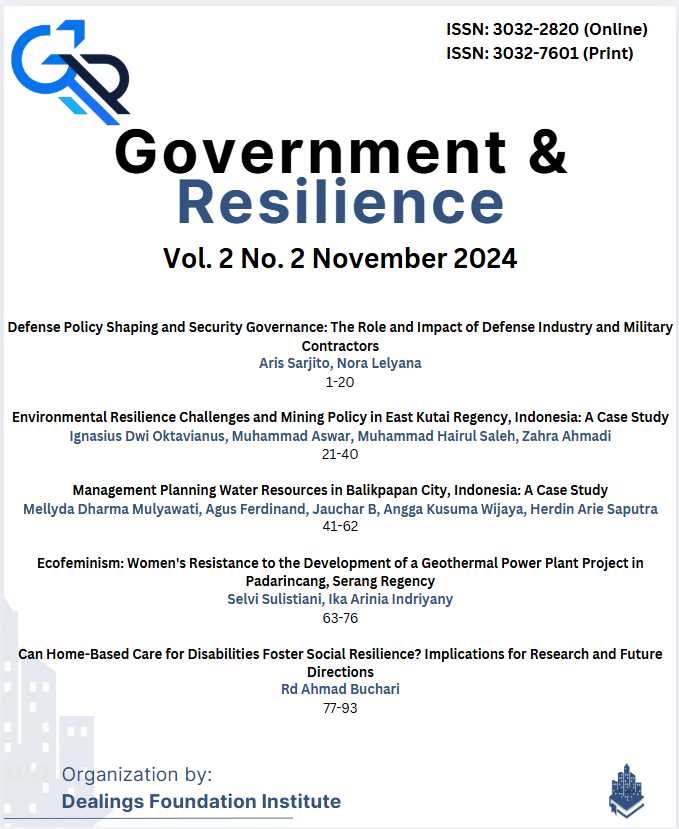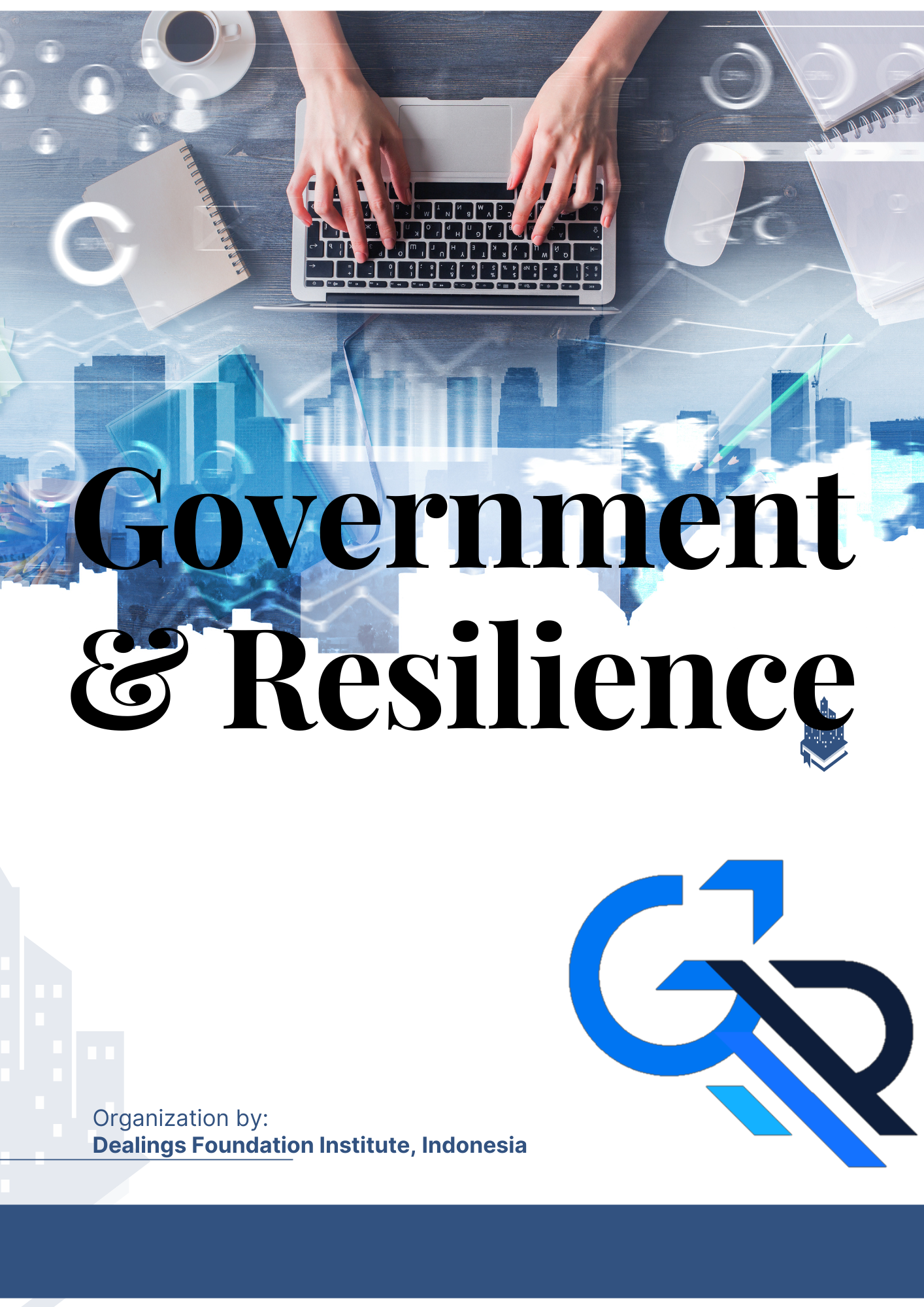Defense Policy Shaping and Security Governance: The Role and Impact of Defense Industry and Military Contractors
DOI:
https://doi.org/10.62503/gr.v2i2.15Keywords:
defense contractors, defense R&D, lobbying, revolving door, technological advancementsAbstract
This research explores the pivotal role of defense contractors in shaping defense policy and their significant impact on national security dynamics. Using qualitative research methods, with an emphasis on secondary data analysis, the study synthesizes findings from government reports, academic literature, and industry analyses. Key findings reveal the considerable influence of defense contractors’ lobbying activities on defense budget allocations and procurement policies, often redirecting resources toward projects that align with their technological expertise and profit motives. Additionally, defense contractors play a crucial role in shaping defense research and development priorities, driving innovation in areas such as cybersecurity, missile defense systems, and unmanned technologies. Ethically, the revolving door phenomenon between defense contractors and government officials raises concerns about potential conflicts of interest, undermining impartial decision-making and public trust. This research offers a comprehensive understanding of the strategic implications of contractor influence on defense policy, highlighting the need for greater transparency, accountability, and balanced competition in defense procurement. By illuminating these dynamics, the study contributes to policy discussions aimed at promoting ethical governance and ensuring the integrity of national security.
References
Adams, G. (2020). The politics of defense contracting: The iron triangle. Routledge.
Adams, J. (1998). The next world war: Computers are the weapons and the front line is everywhere. Simon and Schuster.
Braun, V., & Clarke, V. (2006). Using thematic analysis in psychology. Qualitative Research in Psychology, 3(2), 77–101. https://doi.org/10.1191/1478088706QP063OA
Campbell, C. C., & Auerswald, D. P. (2015). Congress and civil-military relations. Georgetown University Press.
Carnegie Endowment for International Peace. (2023). Strengthening R&D Transparency for Aligned Defense Innovation. . Carnegie Endowment for International Peace.
Center for International Policy. (2021). The Revolving Door and Strategic Risks in Defense Policy. Center for International Policy. [online] available at https://internationalpolicy.org/ accessed on September 2024
Center for Responsive Politics. (2021). Lobbying Database. [online] available at https://www.opensecrets.org accessed on September 2024
Center for Strategic and International Studies (CSIS). (2021). The Role of Defense Contractors in Military Technological Innovation. Center for Strategic and International Studies.
Congressional Research Service. (2023). Department of Defense Research, Development, Test, and Evaluation (RDT&E): Appropriations Structure. Congressional Research Service. https://crsreports.congress.gov/product/pdf/IF/IF10553
Creswell, J. W. (2014). Research Design: Qualitative, Quantitative, and Mixed Methods Approaches. SAGE Publications.
Department of Defense (DoD). (2020). Annual Report. [online] available at https://www.defense.gov/News/Releases/Release/Article/2332126/dod-releases-2020-report-on-military-and-security-developments-involving-the-pe/ accessed on September 2024
Drutman, L. (2015). The business of America is lobbying: How corporations became politicized and politics became more corporate. Oxford University Press.
Dunne, J. P., & Sköns, E. (2010). The Changing Role of the Defense Industry in the Defense Policy. The Economics of Peace and Security Journal, 5(1), 5–11.
Dunne, J. P., & Sköns, E. (2014). The military industrial complex. In The global arms trade (pp. 281-292). Routledge.
Dvir, D., & Tishler, A. (2000). The changing role of the defense industry in Israel's industrial and technological development. Defense Analysis, 16(1), 33-51. https://doi.org/10.1080/713604690
Elo, S., & Kyngäs, H. (2008). The qualitative content analysis process. Journal of Advanced Nursing, 62(1), 107–115.
Gholz, E., & Sapolsky, H. M. (2020). Restructuring the U.S. Defense Industry. International Security, 24(3), 5–51.
Gholz, E., & Sapolsky, H. M. (2022). Defense Acquisition Reform: Assessing the State of the Art. Journal of Strategic Studies.
Gibbs, G. R. (2007). Analyzing Qualitative Data. SAGE Publications.
Government Accountability Office (GAO). (2022). Defense Acquisition: Better Alignment Needed Between Industry R&D and DoD Priorities. . Government Accountability Office (GAO) .
Government Accountability Office. (2022). Defense Science and Technology: Adopting Best Practices Can Improve Innovation Investments and Management. Government Accountability Office. https://www.gao.gov/products/gao-22-104453
Hartung, W. D. (2010). Prophets of war: Lockheed Martin and the making of the military-industrial complex. ReadHowYouWant. com.
He, Y. (2018). The trade-security nexus and US policy making in critical minerals. Resources Policy, 59, 238–249.
Hunter, A. P., & Crotty, R. (2015). Keeping the Technological Edge. Rowman & Littlefield.
Jones, B., & Kane, T. (2024). Artificial Intelligence and Autonomous Systems in Defense: A New Frontier. Military Technology Review.
Kang, K. (2016). Policy influence and private returns from lobbying in the energy sector. The Review of Economic Studies, 83(1), 269-305. https://doi.org/10.1093/restud/rdv029
Kitchenham, B. (2004). Procedures for performing systematic reviews. Keele, UK, Keele University, 33(2004), 1–26.
Kollias, C., & Paleologou, S. M. (2019). Defense Spending and Growth in the European Union: A Causality Analysis. Journal of Policy Modeling, 25(8), 99–117.
Konda, S. R. (2022). Ethical Considerations in the Development and Deployment of AI-Driven Software Systems. INTERNATIONAL JOURNAL OF COMPUTER SCIENCE AND TECHNOLOGY, 6(3), 86–101.
Kotila, B., Drezner, J. A., Bartels, E. M., Hill, D., Hodgson, Q. E., Huilgol, S. S., ... & Wong, J. P. (2023). Strengthening the defense innovation ecosystem. RAND Corporation.
Lavallee, T. (2003). Globalizing the iron triangle: Policy-making within the US defense industrial sector. Defense & Security Analysis, 19(2), 149-164. https://doi.org/10.1080/1475179032000083361
MacDonald, J. (2013). Systematic approaches to a successful literature review. Journal of the Canadian Health Libraries Association/Journal de l'Association des bibliothèques de la santé du Canada, 34(1), 46-47. https://doi.org/10.5596/c13-009
MacDonald, J. (2013). Systematic approaches to a successful literature review. Journal of the Canadian Health Libraries Association/Journal de l'Association des bibliothèques de la santé du Canada, 34(1), 46-47. https://doi.org/10.5596/c13-009
Markusen, A. (2020). The Rise of the Gunbelt: The Military Remapping of Industrial America. Oxford University Press.
Mayer, K. R. (2018). The Political Economy of Defense Contracting. Yale University Press.
National Defense Industrial Association (NDIA). (2024). Fostering a More Competitive Defense Industrial Base: A Policy Framework for Innovation and Security. National Defense Industrial Association (NDIA) .
Quincy Institute for Responsible Statecraft. (2024). The Publicly Funded Defense Contractor Revolving Door. .
Raudzens, G. (1990). War-winning weapons: the measurement of technological determinism in military history. The Journal of Military History, 54(4), 403. https://www.proquest.com/openview/24440e3aeaa5f8aaaf738bda239db243/1?pq-origsite=gscholar&cbl=1819215
Ripberger, J. T., Gupta, K., Silva, C. L., & Jenkins‐Smith, H. C. (2014). Cultural theory and the measurement of deep core beliefs within the advocacy coalition framework. Policy Studies Journal, 42(4), 509–527.
Ritchie, J., & Lewis, J. (2003). Qualitative Research Practice: A Guide for Social Science Students and Researchers. SAGE Publications.
Schwartz, M. (2014). Defense acquisitions: How DoD acquires weapon systems and recent efforts to reform the process.
Schwartz, M. (2021). The Revolving Door: Examining Ethics, Conflicts of Interest, and Federal Oversight in the Changing Business of Defense. Public Administration Review, 81(4), 576–590.
Singer, P. W. (2008). Corporate Warriors: The Rise of the Privatized Military Industry. Cornell University Press.
Smithberger, M. (2023). Defense Spending and Strategic Misalignment: A Critical Analysis. Defense Policy Journal.
Stimson Center. (2023). The Impact of Defense Contractor Lobbying on Resource Allocation and National Security Strategy. . Stimson Center .
Stockholm International Peace Research Institute (SIPRI). (2021). SIPRI Yearbook 2021: Armaments, Disarmament, and International Security. Oxford University Press.
The New York Times. (2023). Investigation into Defense Earmarks and Lobbying Influence . The New York Times.
The Washington Post. (2024). The Revolving Door and Regulatory Capture in the Defense Industry. The Washington Post.
Transparency International. (2023). Defense Industry Transparency: Mitigating Conflicts of Interest Through Effective Cooling-Off Periods. [online] available at https://ti-defence.org/ accessed on September 2024
Downloads
Published
How to Cite
Issue
Section
License
Copyright (c) 2024 Government & Resilience

This work is licensed under a Creative Commons Attribution-NonCommercial-ShareAlike 4.0 International License.
1. Licence
Use of articles will be governed by the Creative Commons Attribution-NonCommercial-ShareAlike 4.0 International license as currently displayed on the Creative Commons Attribution-NonCommercial-ShareAlike 4.0 International License (CC BY-NC-SA 4.0).
2. Author(s)' Warranties
The author warrants that the article is original, written by the stated author(s), has not been published before, contains no unlawful statements, does not infringe the rights of others, is subject to copyright that is vested exclusively in the author and free of any third-party rights, and that any necessary written permissions to quote from other sources have been obtained by the author(s).
3. User Rights
The spirit of Government & Resilience is to disseminate articles published as freely as possible. Under the Creative Commons license, Government & Resilience permits users to copy, distribute, display, and perform the work. Users will also need to attribute authors and Government & Resilience for distributing works in journals and other media of publication.
4. Rights of Authors
Authors retain all their rights to the published works, such as (but not limited to) the following rights:
1. Copyright and other proprietary rights relating to the article, such as patent rights,
2. The right to use the substance of the article in future works, including lectures and books,
3. The right to reproduce the article for own purposes,
4. The right to enter into separate, additional contractual arrangements for the non-exclusive distribution of the article's published version (e.g., post it to an institutional repository or publish it in a book), with an acknowledgment of its initial publication in this journal (Government & Resilience).
5. Co-Authorship
If the article was jointly prepared by more than one author, any author submitting the manuscript warrants that he or she has been authorized by all co-authors to agree on this copyright and license notice (agreement) on their behalf and agrees to inform his or her co-authors of the terms of this policy. Government & Resilience will not be held liable for anything that may arise due to the author's internal dispute. Government & Resilience will only communicate with the corresponding author.
6. Royalties
Being an open-access journal and disseminating articles for free under the Creative Commons license term mentioned, the author(s) are aware that Government & Resilience entitles the author(s) to no royalties or other fees.











